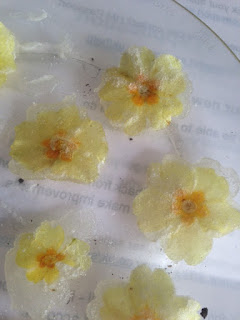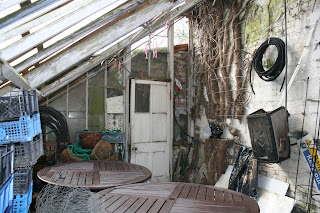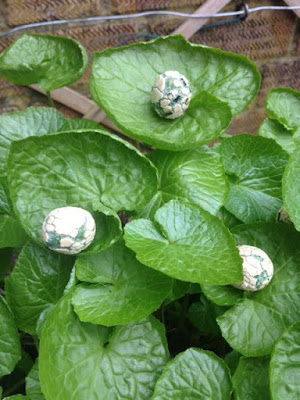We've been enjoying the long weekend in the garden. Whilst you can't really be sure there will not be any overnight frosts at the moment, things need potting on and everything is growing so quickly with the lengthening daylight hours.
In my small courtyard garden there is precious little gardening space, so in a sunny part of the garden I use these large growbags, which are double the size of the small ones and just right for growing frut and veg. I bought these frames last year and they fit 3 bamboo canes so that tomato plants can grow upright.
I am taking a bit of a risk planting these two tomato plants outside at this time of year but they were getting so pot bound that I decided to give it a go. I can cover them in a fleece if I think they are in danger. I am using a plastic flowerpot with the bottom cut out. This is called a
'ring culture' - it restricts the smaller growth roots at the top of the root system while the longer tap roots which collect water go down into the growbag. It also increases the amount of soil available in a small space. You feed the top, and water the bottom. Left is a
Sungold tomato and right is a
Chocolate cherry tomato.

This
Last year I grew new potatoes in a plastic growbag. Well, actually I was a bit lazy last year and didn't get around to clearing up the bag and compost after I had harvested most of them. So, you can see that these last few potatoes have sprouted up as volunteers! This is my favourite variety Epicure. I will make sure I top dress with some compost so that there are plenty of nutrients in this compost because it was used last year and potatoes are greedy feeders. I will make sure they are well fed and watered. The little potatoes survived the Winter very well.
Just a few days ago I decided to plant a few squash seeds. It is recommended that you plant 2 or 3 seeds in a pot and then choose the strongest plant to pot on. Well you can clearly see the reason for this - on the left side are my
Uchiki Kuri squash seeds. One of the 3 is growing strongly, one is a little mis-shapen and still quite strong, and the 3rd is tiny and unhealthy. Do not be tempted to mollycoddle this little seeding! However much you try to nurse it back to life it will never do well and it will be a waste of time and space. Chuck it out! The pot on the right side are amazingly strong and healthy!
Romanesco courgettes from Seeds of Italy. All germinated in just 2 days, coming along really strongly. Time for potting on this weekend methinks!
 This
This





































